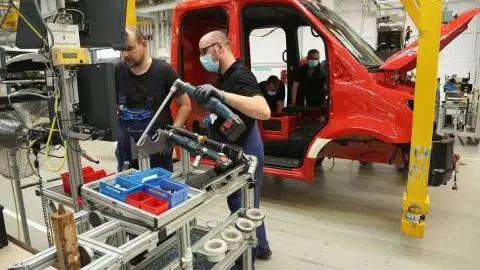Car industry faces more supply-side challenges ahead
With economies recovering worldwide, car production and sales continue to rebound in 2021. Yet, uncertainty around a potential fourth wave of infections with variants spreading, unresolved supply issues caused by supply chain disruptions and material shortages, as well as rising prices, pose downside risks to our outlook
Worldwide automotive production saw an unprecedented fall in 2020 due to factory and car dealership shutdowns, the distortion of supply chains, and complete lockdowns of countries due to the coronavirus pandemic. All of the main producing countries saw sharp declines, leading to a 16% year-on-year drop in world auto production including cars, trucks and buses, according to OICA data. In the second half of 2020, however, some markets recovered very quickly, with Asian production declining by only 10% year-on-year. The Chinese and South Korean markets performed particularly well due to a quick reopening of their economies and pent-up demand.
Lack of semiconductors will persist
With economies recovering worldwide, car production and sales will continue to rebound in 2021, potentially by 7% to 9% compared to last year. Yet the road remains bumpy for unhindered car production this year due to supply chain frictions, mainly the lack of semiconductors for OEMs. When car production slumped last year, orders for car parts were cancelled, while demand from other industry branches rose. Together with the production problems in Taiwan due to the drought, OEMs faced a significant shortage when the overall economic outlook brightened faster than initially expected. The semiconductor problem has turned out to be quite persistent, not only impacting this year’s production numbers but also next year’s, resulting in a potential loss of five million vehicles this year and three million next, according to the Center for Automotive Research. As our consumer goods become ever smarter, the need for electronics, and thus the need for semiconductors, is rising. This is not only true for car manufacturers, but also for consumer electronics, computing and wireless communication, meaning that the battle for chips will continue.
What about demand?
We did not expect Covid to hit car demand on a lasting basis, and the data has proved us right. Demand remains high despite the pandemic, with the current problems in the market clearly being due to a supply shock. Order books are full, economic growth is rebounding and consumers are as confident as before the crisis. In the EU and eurozone, economic sentiment hit a 21-year high in June 2021, with the intention to buy a car within the next 12 months almost being back to pre-coronavirus levels. Private balance sheets proved resilient, according to IMF data, despite higher unemployment and shorter working hours, as policy measures helped households maintain financial stability. In the US, consumer confidence also rose strongly and is currently at the highest level since March 2020. In China, however, sentiment has started to falter as of late with demand for cars being soft in May, growing only 4.5% year-on-year as risks to the economy pile up.
Electrification means a battle for chips and batteries
The EU’s ambitious ‘Fit for 55’ climate goals, which must still be ratified, do not represent an immediate risk to our production outlook as OEMs have been working on the electrification of their production targets for some time now. In addition to reliable infrastructure, demand for EVs is key and this has seen a significant surge in the EU over the last year. Sales of battery electric vehicles more than doubled between 2019 and 2020 while sales of plug-in hybrids more than tripled, resulting in over one million units in 2020. If the current speed were to persist, all new registrations in the EU could be electrically powered by 2030. Regardless of the speed, however, competition for batteries and electric components is set to heat up given the ever-growing need for entertainment technology, potentially leading to another round of supply shocks in the next couple of years.
Sales outlook
Overall, we expect global new car production and registrations to bounce back moderately this year, with light vehicle sales growing 7% to 9% in 2021. Nevertheless, uncertainty around a potential fourth wave of infections with variants spreading, unresolved supply issues caused by supply chain disruptions and material shortages, as well as rising prices, pose a downside risk to our sales outlook. As for the years ahead, the phase out of fossil fuel vehicles and rise of electric cars will have the greatest impact on production and sales numbers, with a shortage of components likely resulting in moderate growth rates in the medium term.
Download
Download article30 July 2021
When doves cry This bundle contains {bundle_entries}{/bundle_entries} articlesThis publication has been prepared by ING solely for information purposes irrespective of a particular user's means, financial situation or investment objectives. The information does not constitute investment recommendation, and nor is it investment, legal or tax advice or an offer or solicitation to purchase or sell any financial instrument. Read more

